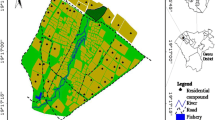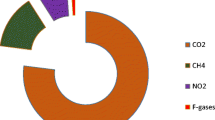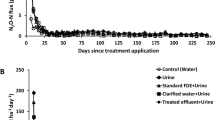Abstract
Purpose
By recycling sewage sludge (SS) to productive land, its plant nutrients can be utilised. However, the use of organic fertilisers carries health risks and causes emissions of nitrous oxide (N2O), methane (CH4) and ammonia (NH3). One measure to sanitise SS from human pathogens is addition of NH3.
Methods
Mesophilically digested and dewatered SS treated with urea and stored, or only stored, was applied to arable land in spring and autumn, respectively, and the effects of immediate or delayed incorporation (by 4 h) on emissions of N2O, CH4 and, in spring, NH3 were investigated.
Results
N2O emissions in autumn from soil treated with SS were significantly higher than from soil without SS application (0.09, 1.31 and 0.68 kg N2O-N ha−1 for control, immediate and delayed incorporation, respectively). These emissions were significantly correlated with volumetric water content in soil. Corresponding N2O emissions in spring were 0.15, 0.57 and 0.41 kg N2O-N ha−1. Delayed incorporation (0.20 and 0.34 % of added N in spring and autumn, respectively) tended to reduce N2O emissions compared with immediate incorporation (0.32 and 0.71 % of added N in spring and autumn, respectively). Nitrous oxide emissions from SS were apparently lower after spring than after autumn application, likely because of drier soil and crop uptake of nitrogen in spring. Methane emissions were negative or negligible. Timing of incorporation had no statistically significant effect on NH3 emissions.
Conclusions
Nitrous oxide emissions from soil treated with SS at a rate based on the maximum permissible P level were moderate and CH4 emissions negligible.


Similar content being viewed by others
References
Swedish Government: Svenska miljömål—för ett effektivare miljöarbete (Swedish environmental goals—for a more efficient environmental work). Proposition 2009/10:155, Regeringen (Swedish Government), Stockholm, Sweden (2009)
SCB: Utsläpp till vatten och slamproduktion 2012. Kommunala reningsverk, massa- och pappersindustri samt övrig industri. (Discharges to water and sewage sludge production in 2012—municipal wastewater treatment plants, pulp and paper industry and other industry, in Swedish with English summary). Produced on behalf of Statistics Sweden and Swedish EPA. MI 22 SM 1401, Statistics Sweden, Stockholm, Sweden (2014)
Swedish EPA: Aktionsplan för återföring av fosfor ur avlopp (Action plan for the return of phosphorus from sewage, in Swedish with English summary). Report 5214, Naturvårdsverket (Swedish EPA), Stockholm, Sweden (2002)
Swedish EPA: Hållbar återföring av fosfor (Sustainable phosphorous recycling, in Swedish with English summary). Report 6580, Naturvårdsverket (Swedish EPA), Stockholm, Sweden (2013)
IPCC: Anthropogenic and natural radiative forcing. Authors: Myhre G, Shindell D, Bréon FM, Collins W, Fuglestvedt J, Huang J, Koch D, Lamarque JF, Lee D, Mendoza B, Nakajima T, Robock A, Stephens G, Takemura T, Zhang H. In: Stocker TF, Qin D, Plattner GK, Tignor M, Allen SK, Boschung J, Nauels A, Xia Y, Bex V, Midgley PM (ed) Climate Change 2013: The physical science basis. Contribution of working group I to the fifth assessment report of the Intergovernmental panel on climate change, pp. 659–740. Cambridge University Press, Cambridge (2013)
Firestone, M.K., Davidson, E.A.: Microbiological basis of NO and N2O production and consumption in soil. In: Andrae, M.O., Schimel, D.S. (eds.) Exchange of Trace Gases Between Terrestrial Ecosystems and the Atmosphere, vol. 47, pp. 7–21. Wiley, Chichester (1989)
Stenberg, B., Pell, M., Torstensson, L.: Integrated evaluation of variation in biological, chemical and physical soil properties. Ambio 27, 9–15 (1998)
Lynch, M., Neufeld, J.: Ecology and exploration of the rare biosphere. Nature 13, 217–229 (2015)
Peters, V., Conrad, R.: Methanogenic and other strictly anaerobic bacteria in desert soil and other oxic soils. Appl. Environ. Microbiol. 61, 1673–1676 (1995)
Le Mer, J., Roger, P.: Production, oxidation, emission and consumption of methane by soils: a review. Eur. J. Soil Biol. 37, 25–50 (2001)
Smith, K., Ball, T., Conen, F., Dobbie, K., Massheder, J., Rey, A.: Exchange of greenhouse gases between soil and atmosphere: interactions of soil physical factors and biological processes. Eur. J. Soil Sci. 54, 779–791 (2003)
Goedkoop, M., Heijungs, R., Huijbregts, M., De Schryver, A., Struijs, J., van Zelm, R. (eds.): ReCiPe 2008—A Life Cycle Impact Assessment Method Which Comprises Harmonised Category Indicators at the Midpoint and the Endpoint Level, First edition, Report I: Characterisation. Ministry of Housing, Spatial Planning and Environment (VROM), Haag (2009)
Mosier, A., Hutchinson, G., Sabey, B., Baxter, J.: Nitrous oxide emissions from barley plots treated with ammonium nitrate or sewage sludge. J. Environ. Qual. 11, 78–81 (1982)
Scott, A., Ball, B., Crichton, I., Aitken, M.: Nitrous oxide and carbon dioxide emissions from grassland amended with sewage sludge. Soil Use Manag. 16, 36–41 (2000)
Ambus, P., Jensen, J., Priemé, A., Pilegaard, K., Kjøller, A.: Assessment of CH4 and N2O fluxes in a Danish beech (Fagus sylvatica) forest and an adjacent N-fertilised barley (Hordeum vulgare) field: effects of sewage sludge amendments. Nutr. Cycl. Agroecosyst. 60, 15–21 (2001)
Chiaradia, J.J., Chiba, M.K., do Andrade, C.A., de Carmo, J.B., de Oliveira, C., Lavorenti, A.: CO2, CH4 and N2O fluxes in an Ultisol treated with sewage sludge and cultivated with castor bean. Rev. Bras. Ciênc. Solo 33, 1863–1870 (2009)
Fernández-Luqueño, F., Reyes-Varela, V., Martínez-Suárez, C., Reynoso-Keller, R., Méndez-Bautista, J., Ruiz-Romero, E., López-Valdez, F., Luna-Guido, M., Dendooven, L.: Emission of CO2 and N2O from soil cultivated with common bean (Phaseolus vulgaris L.) fertilized with different N sources. Sci. Total Environ. 407, 4289–4296 (2009)
Aguilar-Chávez, Á., Díaz-Rojas, M., del Rosario Cárdenas-Aquino, M., Dendooven, L., Luna-Guido, M.: Greenhouse gas emissions from a wastewater sludge-amended soil cultivated with wheat (Triticum spp. L.) as affected by different application rates of charcoal. Soil Biol. Biochem. 52, 90–95 (2012)
de Urzedo, D.I., Franco, M.P., Pitombo, L.M., do Carmo, J.B.: Effects of organic and inorganic fertilizers on greenhouse gas (GHG) emissions in tropical forestry. For. Ecol. Manag. 310, 37–44 (2013)
Díaz-Rojas, M., Aguilar-Chávez, Á., del Rosario Cárdenas-Aquino, M., Ruíz-Valdiviezo, V.M., Hernández-Valdez, E., Luna-Guido, M., Olalde-Portugal, V., Dendooven, L.: Effects of wastewater sludge, urea and charcoal on greenhouse gas emissions in pots planted with wheat. Appl. Soil Ecol. 73, 19–25 (2014)
Pitombo, L.M., do Carmo, J.B., de Maria, I.C., de Andrade, C.A.: Carbon sequestration and greenhouse gases emissions in soil under sewage sludge. Sci. Agric. 72, 147–156 (2015)
Perälä, P., Kapuinen, P., Esala, M., Tyynelä, S., Regina, K.: Influence of slurry and mineral fertiliser application techniques on N2O and CH4 fluxes from a barley field in southern Finland. Agric. Ecosyst. Environ. 117, 71–78 (2006)
Velthof, G., Mosquera, J.: The impact of slurry application technique on nitrous oxide emission from agricultural soils. Agric. Ecosyst. Environ. 140, 298–308 (2011)
Wulf, S., Maeting, M., Clemens, J.: Application technique and slurry co-fermentation effects on ammonia, nitrous oxide, and methane emissions after spreading. J. Environ. Qual. 31, 1795–1801 (2002)
Parkin, T., Kaspar, T., Singer, J.: Cover crop effects on the fate of N following soil application of swine manure. Plant Soil 289, 141–152 (2006)
Jarecki, M.K., Parkin, T.B., Chan, A.S., Kaspar, T.C., Moorman, T.B., Singer, J.W., Kerr, B.J., Hatfield, J.L., Jones, R.: Cover crop effects on nitrous oxide emission from a manure-treated Mollisol. Agric. Ecosyst. Environ. 134, 29–35 (2009)
Malgeryd, J.: Technical measures to reduce ammonia losses after spreading of animal manure. Nutr. Cycl. Agroecosyst. 51, 51–57 (1998)
Thomsen, I.K., Pedersen, A.R., Nyord, T., Petersen, S.O.: Effects of slurry pre-treatment and application technique on short-term N2O emissions as determined by a new non-linear approach. Agric. Ecosyst. Environ. 136, 227–235 (2010)
Thorman, R., Chadwick, D., Harrison, R., Boyles, L., Matthews, R.: The effect on N2O emissions of storage conditions and rapid incorporation of pig and cattle farmyard manure into tillage land. Biosyst. Eng. 97, 501–511 (2007)
Sommer, S., Sherlock, R., Khan, R.: Nitrous oxide and methane emissions from pig slurry amended soils. Soil Biol. Biochem. 28, 1541–1544 (1996)
Clemens, J., Vandré, R., Kaupenjohann, M., Goldbach, H.: Ammonia and nitrous oxide emissions after landspreading of slurry as influenced by application technique and dry matter-reduction. II. Short term nitrous oxide emissions. Z. Pflanzenernähr. Bodenk. 160, 491–496 (1997)
Webb, J., Chadwick, D., Ellis, S.: Emissions of ammonia and nitrous oxide following incorporation into the soil of farmyard manures stored at different densities. Nutr. Cycl. Agroecosyst. 70, 67–76 (2004)
Velthof, G., Kuikman, P., Oenema, O.: Nitrous oxide emission from animal manures applied to soil under controlled conditions. Biol. Fertil. Soils 37, 221–230 (2003)
Fidjeland, J., Lalander, C., Jönsson, H., Vinnerås, B.: Ammonia sanitisation of sewage sludge using urea. Water Sci. Technol. 68, 1866–1872 (2013)
FAO: Guidelines for soil description, 4th edn. Food and agriculture organization of the United Nations, Rome (2006)
KLK: Kungliga Lantbruksstyrelsens kungörelse med (5) bestämmelser för undersökning av jord vid statens lantbrukskemiska kontrollanstalt och lantbrukskemisk station med av staten fastställda stadgar. (The Royal Agricultural Board’s Ordinance with (5) regulations for the investigation of soil at the State Agricultural chemical inspection institute and agricultural chemical station with the State established statutes, in Swedish). The Royal Agricultural Board’s Ordinance number 1 (1965)
Rodhe, L., Pell, M., Yamulki, S.: Nitrous oxide, methane and ammonia emissions following slurry spreading on grassland. Soil Use Manag. 22, 229–237 (2006)
Svensson, L.: A new dynamic chamber technique for measuring ammonia emissions from land-spread manure and fertilizers. Acta Agric. Scand. Sect. B Soil Plant Sci. 44, 33–46 (1994)
Petersen, S.O., Andersen, M.N.: Influence of soil water potential and slurry type on denitrification activity. Soil Biol. Biochem. 28, 977–980 (1996)
Davidson, E.A., Rogers, J., Whitman, W.: Fluxes of nitrous oxide and nitric oxide from terrestrial ecosystems. In: Rogers, J.E., Whitman, W.B. (eds.) Microbial production and consumption of greenhouse gases: methane, nitrogen oxides, and halomethanes, pp. 219–235. American Society for Microbiology, Washington DC (1991)
FAO and IFA: Global Estimates of Gaseous Emissions of NH3, NO and N2O from Agricultural Land. International Fertilizer Industry Association and Food and Agriculture Organization of the United Nations, Rome (2001)
Karlsson, S., Rodhe, L.: Översyn av Statistiska Centralbyråns beräkning av ammoniakavgången i jordbruket – emissionsfaktorer för ammoniak vid lagring och spridning av stallgödsel (A review of Statistics Sweden’s calculation of ammonia emissions in the agriculture – emission factors for ammonia storage and spreading of manure, in Swedish). Carried out on behalf of the Swedish Board of Agriculture. Swedish Institute of Agricultural and Environmental Engineering (JTI) Uppsala, Sweden (2002)
Beauchamp, E., Kidd, G., Thurtell, G.: Ammonia volatilization from sewage sludge applied in the field. J. Environ. Qual. 7, 141–146 (1978)
Donovan, W.C., Logan, T.J.: Factors affecting ammonia volatilization from sewage sludge applied to soil in a laboratory study. J. Environ. Qual. 12, 584–590 (1983)
Smith, K., Dobbie, K., Ball, B., Bakken, L., Sitaula, B., Hansen, S., Brumme, R., Borken, W., Christensen, S., Priemé, A.: Oxidation of atmospheric methane in Northern European soils, comparison with other ecosystems, and uncertainties in the global terrestrial sink. Glob. Change Biol. 6, 791–803 (2000)
Schaufler, G., Kitzler, B., Schindlbacher, A., Skiba, U., Sutton, M., Zechmeister-Boltenstern, S.: Greenhouse gas emissions from European soils under different land use: effects of soil moisture and temperature. Eur. J. Soil Sci. 61, 683–696 (2010)
Majumder, R., Livesley, S.L., Gregory, D., Arndt, S.K.: Biosolid stockpiles are a significant point source for greenhouse gas emissions. J. Environ. Manag. 143, 34–43 (2014)
Acknowledgments
We gratefully acknowledge Marianne Tersmeden, Anders Ringmar, Johnny Ascue, Tomas Reilander and Linnea Persson for their skilful contributions in field and laboratory work, Birgitta Vegerfors-Persson for statistical advice and Mary McAfee for language editing. The project was funded by the Swedish Research Council Formas and the Development Fund of the Swedish Water Association and supported by the Swedish Environment Protection Agency, Vinnova, Southwest Stockholm region water companies (Syvab), the Käppala Association, Ragnar Sellbergs Foundation and Uppsala, Karlstad and Sunne municipalities.
Author information
Authors and Affiliations
Corresponding author
Rights and permissions
About this article
Cite this article
Willén, A., Jönsson, H., Pell, M. et al. Emissions of Nitrous Oxide, Methane and Ammonia After Field Application of Digested and Dewatered Sewage Sludge With or Without Addition of Urea. Waste Biomass Valor 7, 281–292 (2016). https://doi.org/10.1007/s12649-015-9456-2
Received:
Accepted:
Published:
Issue Date:
DOI: https://doi.org/10.1007/s12649-015-9456-2




